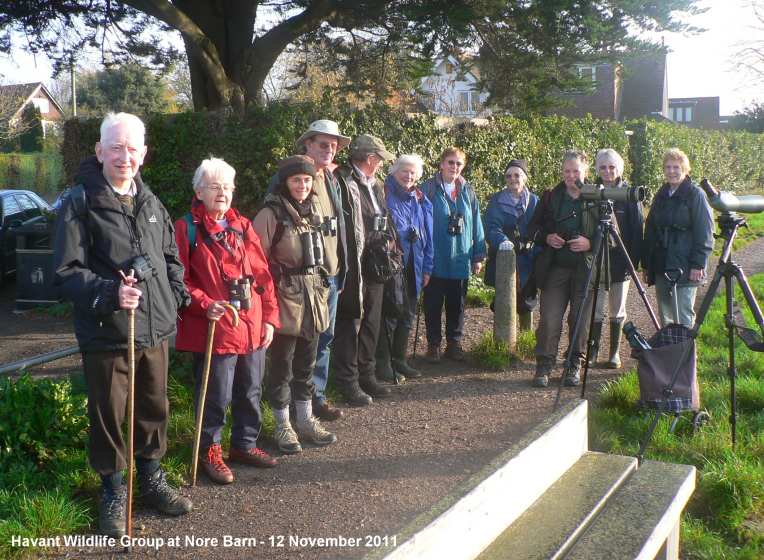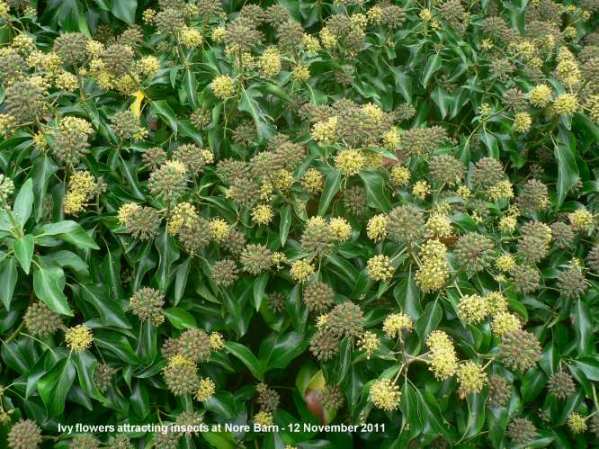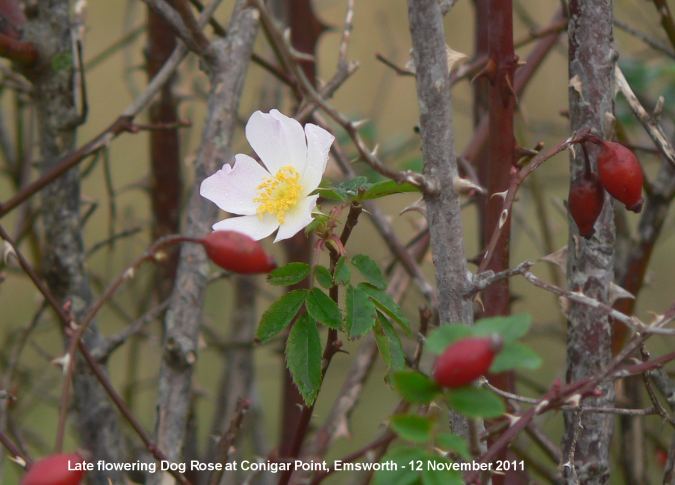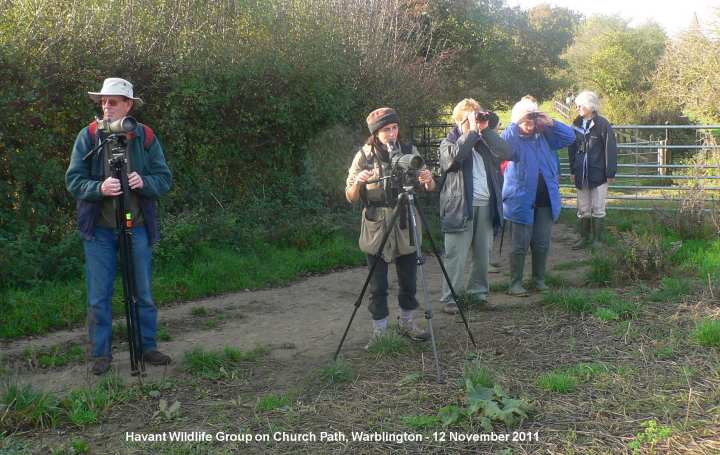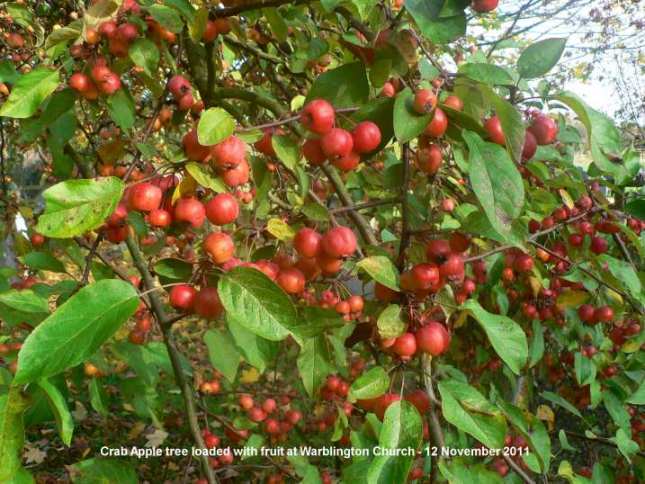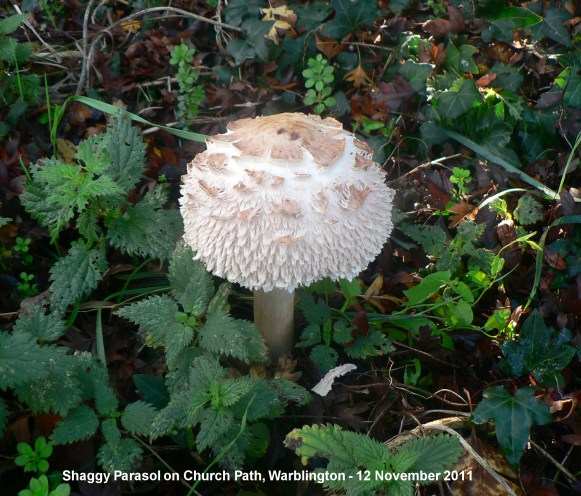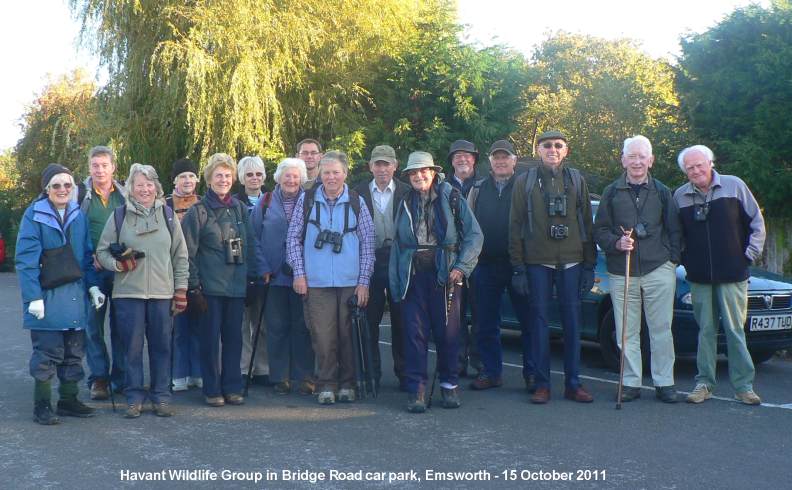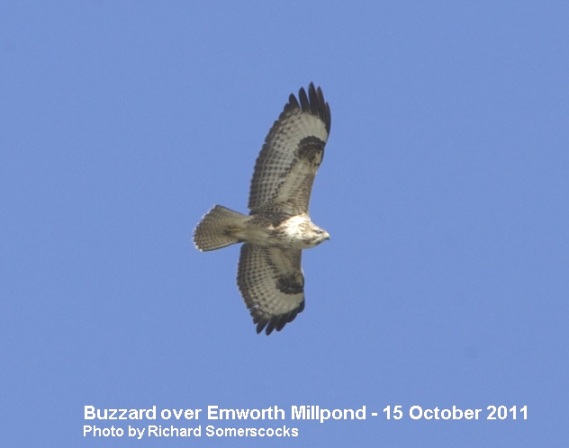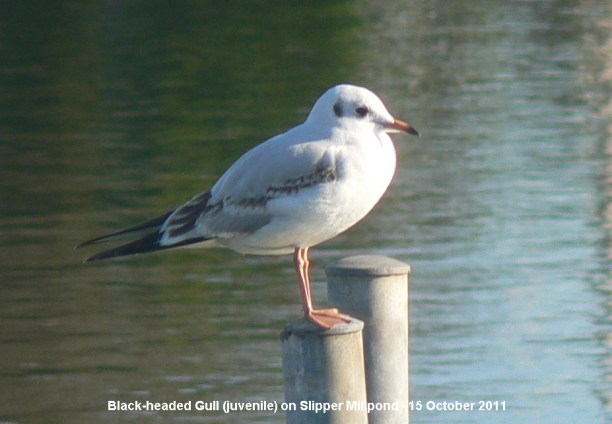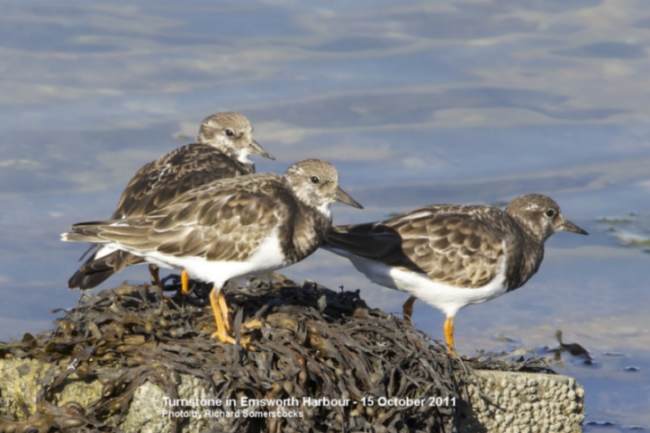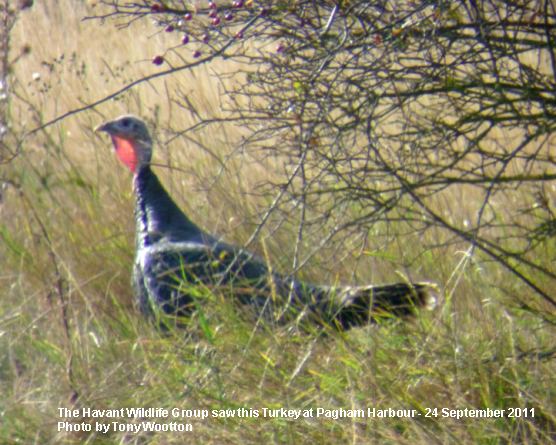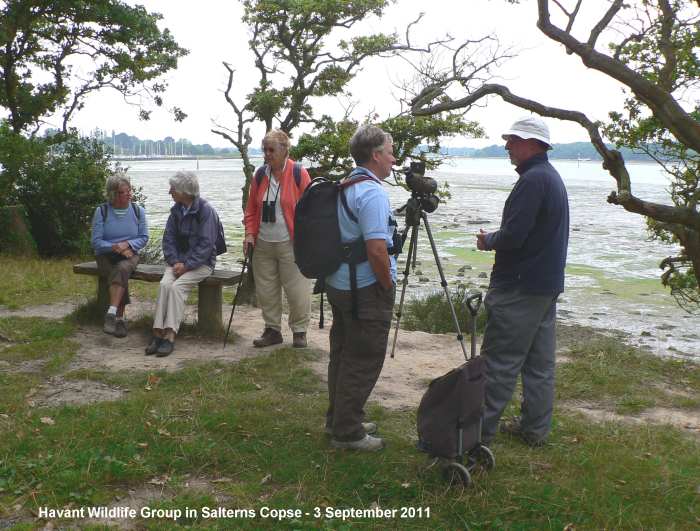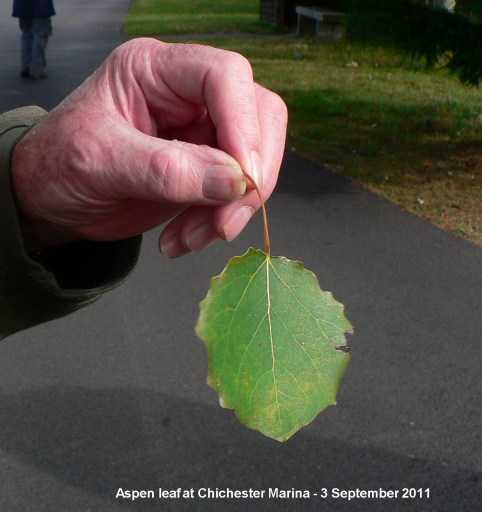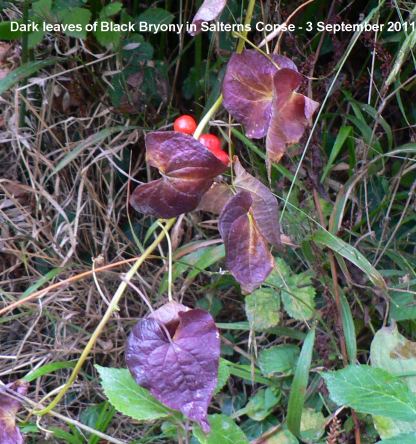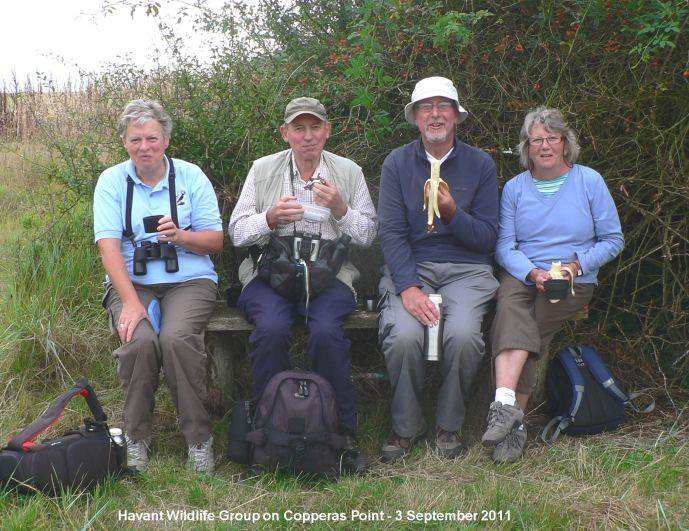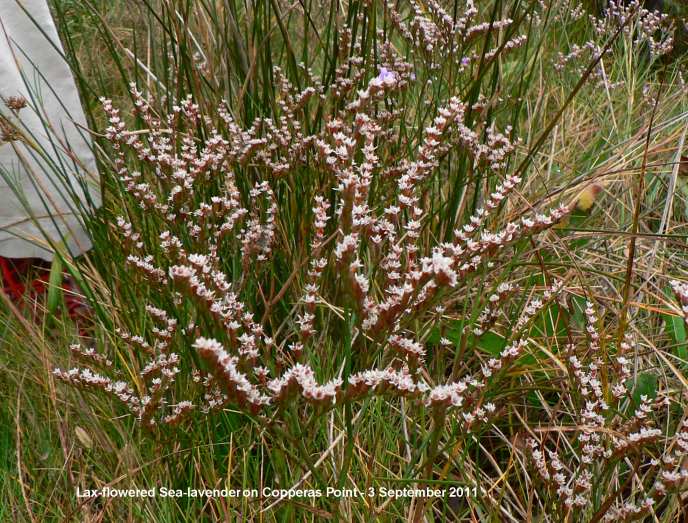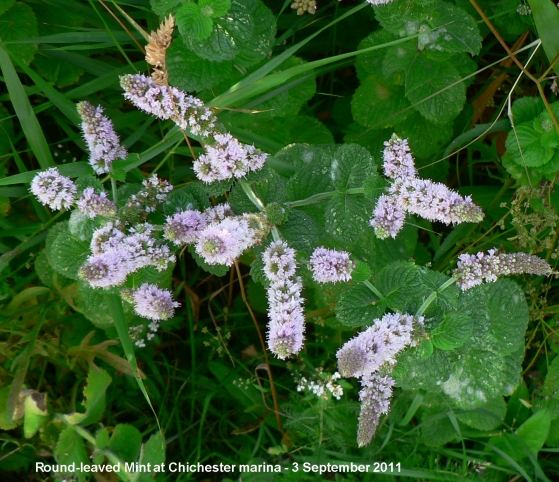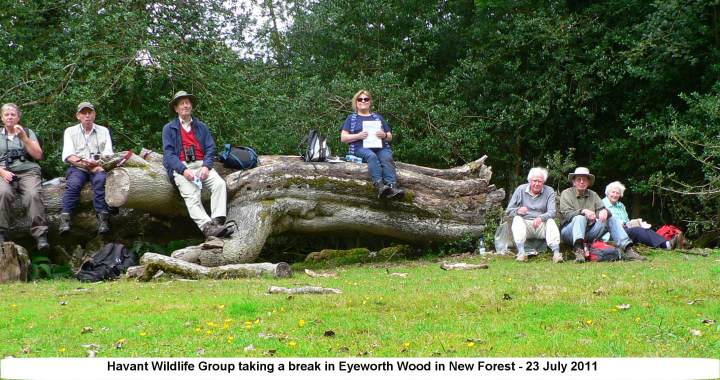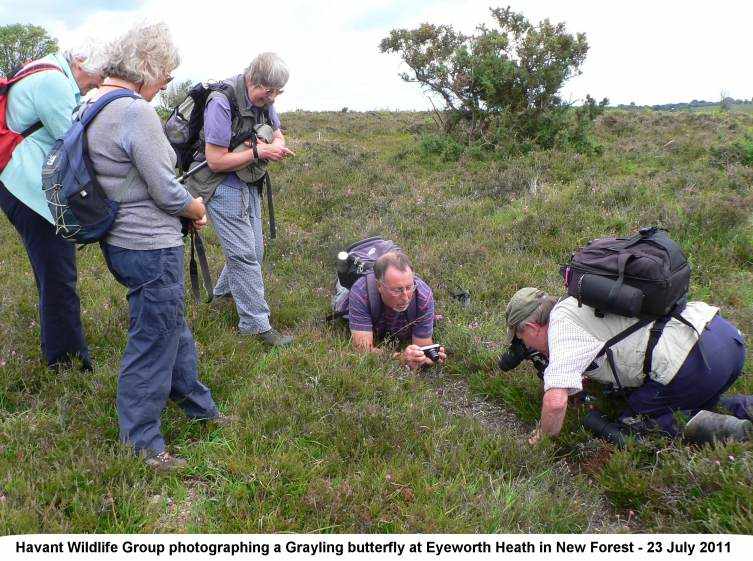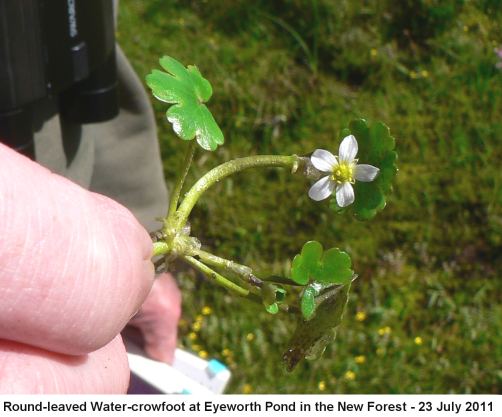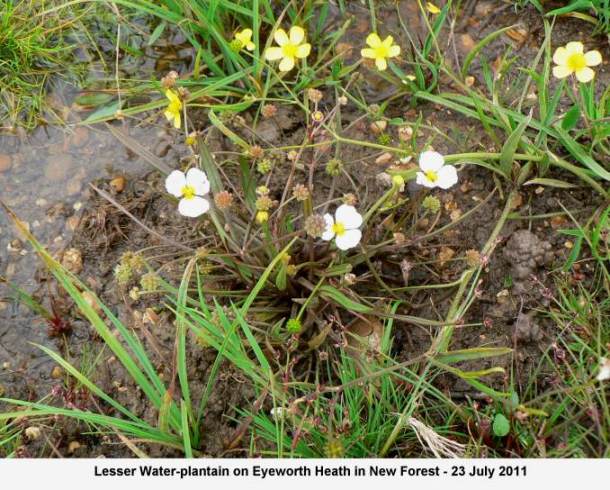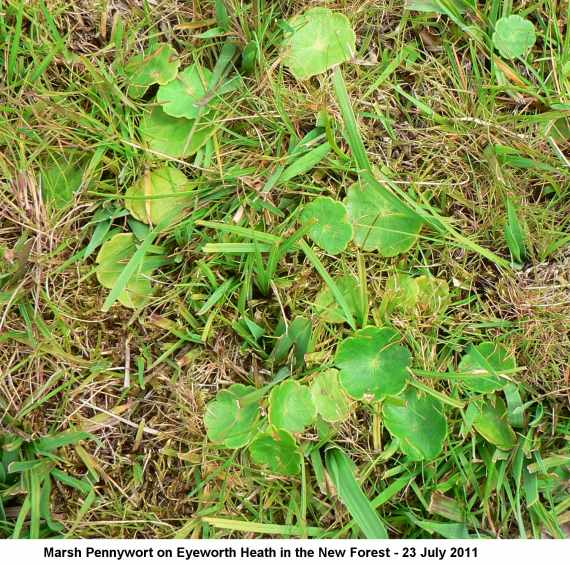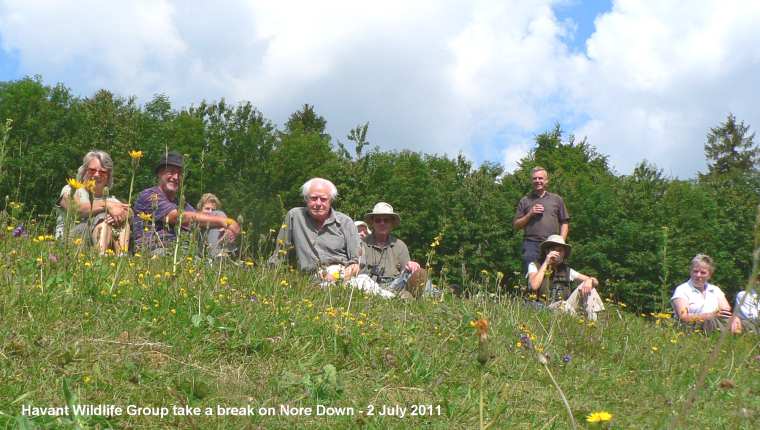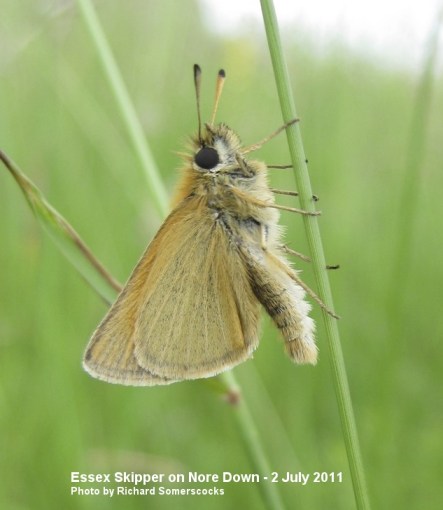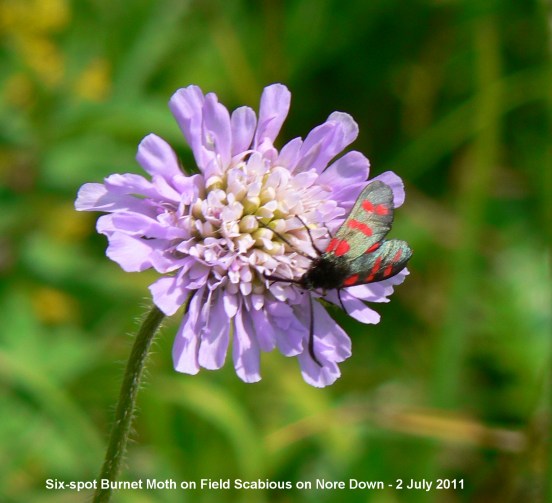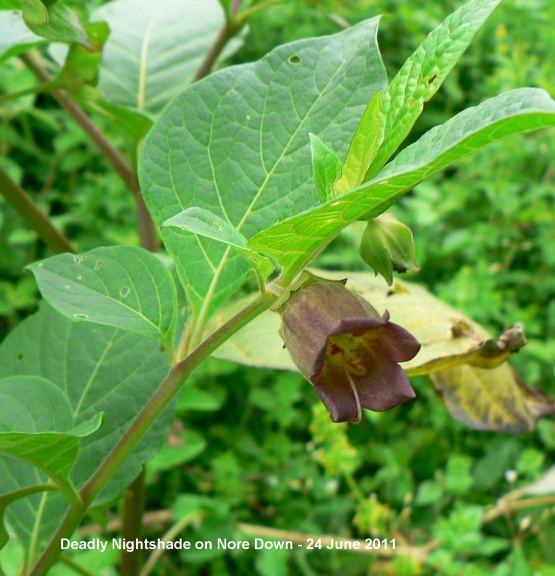RETURN TO . . . Emsworth Wildlife - Homepage . . Havant Wildlife Group -main page
HAVANT WILDLIFE STUDY GROUPREPORTS OF SATURDAY WALKS 2011
SATURDAY NOVEMBER 12 - 2011 - NORE BARN - WARBLINGTON - Report by Brian FellowsTwelve members of the Havant Wildlife Group (including me) attended this morning's walk from Nore Barn to Warblington Church and back. The weather was quite amazing for November, warm and still, much more like September. The tide was rising to high water at 12:00.
Nore Barn
Starting at Nore Barn we were hoping to see the Spotted Redshank, but just before the group arrived a chap paddled his boat along the stream into the harbour, putting up all the birds, including, no doubt, the Spotted Redshank. So, that was that.
However, we did get a fine view of the massed ranks of 130+ Black-tailed Godwits feeding on the mudflats, including a number of colour-ringed birds, all regulars in Emsworth this season.
I did not have time to go through the thoroughly for colour-rings, but the ones I noted were all Emsworth regulars this season: WO+LW flag, ROL+RLR, RYL+RLY, OY+LR
See the special Black-tailed Godwit page on the web site for all the Godwit colour-ringed sightings and photos at . . . http://www.emsworthwildlife.hampshire.org.uk/x-black-tailed-godwit-c-ring.htm
We were also treated to an array of colourful Wigeon and Teal, along with multitude of honking Brent Geese including a good number of juveniles. They have had a good breeding season.
We all had a fine view of a brightly coloured Great Spotted Woodpecker in one of the Crack Willow trees in the north wood.
We stopped to admire an Ivy bush along the path to the south of the woods which was covered in globular clusters of flowers attracting a myriad of insects, flies, bees and wasps.
Shore to Warblington
We stopped to admire some white coloured Dog Rose flowers in the hedgerow around the first bend along the shore.
Tamarisk was also in flower along the shore. We had a look at the Conigar Point field at Warblington Farm where we found Wild Carrot, Scarlet Pimpernel, Black Nightshade, Smooth Sow-thistle, Field Woundwort, Scentless Mayweed and more Dog Roses, as previously noted by Ralph Hollins, pinker than the others. It was good to see the hips and the rose flowers together.
Masses of Brent Geese, Wigeon and Teal were on the water off the Warblington shore. Some people also picked up Dunlin and Ringed Plover before they flew off. 10 Cormorants and 5 Shelduck were on the saltmarshes. Two flotillas of 7 and 5 Red-breasted Mergansers were also on the water.
We had a good view of an over-wintering Chiffchaff whistling away as it looked for insects in the Tamarisk bushes.
Warblington Church
We stopped for a coffee break sitting in warm sunshine in Warblington cemetery. It was here that we had a good view of three Mistle Thrushes flying between the trees with their dry rattle calls and occasionally perching. Also, two Green Woodpeckers were seen. We watched a host of twittering Goldfinches, along with a few Chaffinches, actively feeding in the trees. Caroline spotted a Goldcrest in the churchyard. Caroline also saw a Red Admiral, our one and only butterfly of the morning.
A Holly tree was simply covered in red berries. There was also a Crab Apple tree behind the church with masses of bright red fruits. The Yews also had lots of berries. Some of us had a quick look inside the church, which was looking fine, with no obvious sign of the extensive restoration work following the serious fire.
Church path
We stopped to examine the unusual rayed form of Groundsel, which I fondly recall Gwynne Johnson first showed me along this path many years ago. It has come up every year since.
Jim found the very handsome Shaggy Parasol mushroom beneath the hedge. It had grown substantially since I first saw it yesterday.
Caroline got a beautiful Starling in her scope; it was perched on top of one of the large round bales of straw. A Pied Wagtail was also searching the bales for food.
We found some more Field Woundwort in flower among the Groundsel on the edge of the large field. We noted that it lacked the harsh smell of Hedge Woundwort.
SATURDAY OCTOBER 29 - 2011 - WEST WITTERINGChris Cope reported on yesterday's walk by the Havant Wildlife Group
"Eight of us went to West Wittering today. It was dull and breezy on the shore, with no sea birds in sight, it was three and a half hours before high tide which may have accounted for that. Walking towards Snow Hill we saw a large flock of Brent Geese on the mud, a Grey Plover in summer plumage, a flock of Skylarks and other small birds, possibly Linnets overhead , and had a good view of a juvenile Stonechat.
Due to the lack of sun and the fact that a lot of scrub has been cut down (for sea defence work) we had a better than usual look over Snow Hill and saw Teal, Wigeon, Redshank, Lapwing, Curlew, and one Snipe. At Ella Nore we saw several Great Crested Grebe, 4 Shelducks, and a flock of 40 Golden Plover (Thank you Caroline). The tide was wrong for the high tide roost at the top of Ella Nore Lane, but we were able to add Greenshank to the list when we returned to Snow Hill, there were also large flocks of Brent Geese on the fields and on the water. Caroline counted 41 species.
SATURDAY OCTOBER 15 - 2011 - EMSWORTH HARBOURAn amazing 16 members of the Havant Wildlife Group assembled in Bridge Road car park at 9am for the morning's walk down to the harbour led by myself. Richard Somerscocks and Caroline French joined the group later. The weather was fine and sunny, with a slight chill in the wind. Perfect for birdwatching.
Here is everyone (including me) posing for a group photo in the car park
Emsworth Millpond
We walked round the town millpond, where we noted the usual Mallard, Mute Swans and Coot, but noted the absence of Tufted Duck. They should be on the pond very soon.
On the millpond seawall some members of the group caught sight of a Kingfisher which perched briefly on the wall, before flying off across the calm millpond. A Grey Wagtail also flew over towards the harbour. We all got a good view of the Buzzard soaring over the millpond and then leisurely flying across the harbour towards Hayling Island.
Richard Somerscocks got this excellent photo of the bird as it passed overhead.
and he was dead chuffed to have got it
Emsworth shore
From the town shore we got a good view of 40 or so Black-tailed Godwits huddled together on the edge of the main channel. A group of 5 Greenshank were feeding in the low water channel near the marina entrance. We got a distant view of about 50 Brent Geese on the Thorney Island shore. Three Lapwing were also seen from the town shore.
Dolphin Creek wayside
Walking down the Dolphin Creek conservation wayside we examined the browning leaves of the large Horse Chestnut tree in the garden of Holmwood House, but decided they were not affected by the leaf miner moth. We say our first butterfly of the morning on this wayside, a Speckled Wood.
Slipper Millpond
A Little Grebe was fishing on the southern part of Slipper Millpond, where we noted a juvenile Black-headed Gull perched conveniently on a post for a photo. Juvenile gulls have been scarce this year following the complete failure of the gull breeding colony on the Langstone Harbour islands.
On the way back, Heather spotted a single Common Gull in amongst the Black-headed Gulls on the pond, he first I have seen there this autumn.
Emsworth Harbour
We had our 'coffee break' at about 10.45 sitting on the grassy bank in front of the deckhouses and looking across the wide expanse of Emsworth Harbour, gradually filling with water as the tide rose.
Right in front of us were 46 Black-tailed Godwits on the shore; another 25 were further out, making a total of 71. As most of the Godwits were standing in water reading colour-rings was almost impossible. At 11am all the Godwits flew up and over to Thorney Island, where they have their high water roost probably on the Deeps.
We could see about 50 Dunlin on the green island far out in the main channel; this was the largest number I have recorded in Emsworth this autumn.
Even better than the Godwits, were the 27 Brent Geese on the water, new arrivals in Emsworth this autumn. I saw my first Brents in the harbour only yesterday. Very encouraging was the presence of 12 juveniles in families of 4, 3, 3 and 2, a very promising start to the Brent Goose Breeding Productivity Survey, which I take part in each year. It clearly suggests the geese had a good breeding season.
Richard's photo of the Brents taking off shows two juveniles
Wickor Bank
We walked along the Wickor Bank, just past Little Deep. A Wheatear flitted past us on the seawall. A Red Admiral was flying on the shore. I noticed a Shoveler on the far end of the Little Deep. A Water Rail was heard squealing from the reedbeds. Other birds heard and not seen included Bearded Tit and Cetti's Warbler.
Three Turnstones were on the weedy shore searching for insects - photo by Richard
We had a distant view of the Golden Plover flock (approx 200) roosting on the saltmarshes off the Great Deep. On the way back some of us caught a glimpse of the Green Sandpiper flying off from the Deckhouses Pond. Coming back through Brook Meadow, Ros and I admired the Cow Parsley in full flower on the main river path.
SATURDAY 8 OCTOBER 2011 - HOOK WITH WARSASHChris Cope reported on the Havant Wildlife Group walk yesterday.
"Eight of us walked the Solent Way from Hook yesterday morning, it was very windy, but the bird sightings made up for the chill.
We saw several Great Spotted & Green Woodpeckers, with a Nuthatch & many Long Tailed Tits whilst in the car park, & heard a Jay. There was a continuous flow of birds making their way north up the River Hamble, we saw a flock of Pied Wagtails, Skylark, Canada Geese, Greenfinch & many flocks of Linnets, with numerous Swallows going the wrong way for migration.
A couple of HOS chaps counted 42 Skylarks flying close over the sea going towards Hook. There were also several Great Crested Grebe on the sea. Looking inland over the pond, we saw Teal, Pintail, Widgeon, & a Shoveler, a large flock of Gadwall, & an Egret, plus some Black-Tailed Godwits. A Dartford Warbler gave us a quick warning call & dived into the gorse.
Turning inland Heather & Derek spotted a leucistic pale bird in the small reserve amongst the Willow trees, Derek showed his photos to the HOS birders & they thought it was a Willow Warbler because of it's orange legs. This bird was amongst a flock of Long-Tailed Tits with Chiffchaff & Blue Tits; we caught up with the same flock further along the fields.
Willow Warbler at Hook
Walking back through the fields we saw Pied Wagtails, a Grey Wagtail & Meadow Pipits, four Buzzards, a close Kestrel, a Whinchat with 5 Wheatear; Jays flying over & a Mistle Thrush, & finally a Tree Creeper.
Many thanks to Heather for helping me catalogue all the birds we saw, & Derek for his great photos."
SATURDAY 24 SEPTEMBER - 2011 - PAGHAM HARBOURRos Norton sent the following report of yesterday's walk by the Havant Wildlife Group at Pagham Harbour:
"15 of us met at Pagham Harbour information centre for a walk in direction of Church Norton on a glorious sunny warm morning with little wind . A highlight was a Ruff on Ferry pool when we returned. High tide was about 9.30. There were also many Lapwings on Ferry Pool. Surprisingly we saw a Turkey which flew off (but not before Tony Wootton got a photo of it). Lots of recently released Red Legged Partridges and Pheasants were on the fields. A large number of Canada geese flew over. Long tailed tits and Linnets flew along the hedgerow. Several Grey Herons and Little Egrets were seen. Many Swallows skimmed over the ground. Raptors including Buzzards, Sparrowhawk and Kestrel. Some Curlew and Redshank around and distant Cormorants. Some were lucky to see a Clouded Yellow butterfly and several red admirals,"
Here is Tony Wootton's photo of the Pagham Turkey!
SATURDAY SEPTEMBER 3 - 2011 - CHICHESTER MARINATen members of the Havant Wildlife Group assembled at Chichester Marina car park for their Saturday morning walk through Salterns Copse to Copperas Point. The weather was fine and warm though overcast.
Members of the Havant Wildlife Group in Salterns Copse
Marina area
From the car park, we walked down the main drive to the Peter Catlett hide overlooking the Apuldram Manor Farm Marsh where we watched Swallows skimming the surface of the lake for insects. Cetti's Warbler sang briefly from the reeds. Heather spotted an Osprey flying over the main marina, but we saw nothing more of it.
Nigel pointed out the Aspen trees which have been planted beside the main drive with round leaves on stalks so thin and flattened that they tremble and rustle in the wind. The Oaks alongside the drive were fully laden with acorns.
Chichester Harbour
The tide was low in the harbour and rising while we were there, but very few birds were on the mudflats. About 5 Black-tailed Godwits (no colour-rings) and 3 Greenshank (one in summer plumage) were on the edge of the channel, along with a few Cormorants, Little Egret, Redshank and Oystercatcher. About 20 Curlew could be seen on the rocky shore to the north of Copperas Point. Plenty of Swallows were flying around along with flocks of finches over the open fields.
Salterns Copse
We found the Betony on the side of the western path that I first saw flowering here on Aug 9. An unusual habitat for this plant? It still had a few petals showing, but had largely gone to seed.
The Butcher's-broom had lots of buds showing, but no flowers that we could see. Ferns growing alongside the path included Polypody and Male Fern.
We stopped to admire the green and red berries on the Black Bryony which was twining around the local bushes. Nigel pointed out the very dark leaves from which the plant got its name.
The laurel-like leaves of Spurge Laurel could be seen here and there by the path, but neither a spurge or a laurel according to Blamey, Fitter and Fitter. We also found Broom bushes with black hairy-edged pods.
Other flowering plants included Perforate St John's-wort (the largest flowers of any St John's Wort according to Nigel), Common Centaury, Common Knapweed, Autumn Hawkbit and Honeysuckle.
Walking back along the northern path round the woods we noted the different varieties of plantain and a nice tuft of Wood Sedge.
Copperas Point
We headed for the seats overlooking the saltmarshes where we took our coffee break. Christine pointed out a good growth of Smooth Tare with smooth (non-hairy) seed pods near the seats.
Heather, Derek, Tony and Hilary enjoying a break at Copperas Point
I provided the group with a check list of 16 plants on the saltmarshes, all of which were found. Sea Aster (in flower), Golden Samphire (mostly gone over), Sea Beet (abundant), Sea Plantain (plenty), Sea Arrowgrass (scarce), Annual Seablite (abundant), Glasswort (scarce), Sea Purslane (abundant, some with tiny yellow flowers), Common Sea-lavender and Lax-flowered Sea-lavender (both frequent in one area), Common Cord-grass (widespread), Sea Couch (widespread), Sea Rush (in certain areas), Sea Club-rush (surprisingly scarce), Common Orache (purple coloured which Nigel took for Red Goosefoot last year) and Grass-leaved Orache (scarce). We also found Spear-leaved Orache.
Lax-flowered Sea-lavender was surprisingly common on the sltmarshes
Nigel and I looked in vain for the rare Spreading Hedge Parsley (Torilis arvensis) which we found on our visit last year on the edge of the main path behind the seat. The area of arable weeds on the edge of the field was very overgrown and it could have been hidden away somewhere. As it is an annual plant Nigel thought it might not appear every year.
Our best find in this area was several plants of the rare Marsh Mallow, to the south of the main seat in front of the saltmarshes at Grid Ref: SU 829018. Most of the plants had gone to seed, but one still had flowers.
Marsh Mallow (Althaea officinalis) on the edge of the saltmarshes
As Marsh Mallow (Althaea officinalis) is noted as being a 'missing scarce species' in the New Flora of Sussex I have sent this record to Mike Shaw, the botanical recorder for West Sussex.
Chichester Canal
Most of the group took the southerly route back to the car park, crossing the lock gate and walking alongside the Chichester Canal. Here we saw flocks of up to 20 House Sparrows feeding on the grass verge. Two Red Admirals were feeding on the Hemp Agrimony flowers.
What we assumed was Round-leaved Mint (Mentha suaveolens), from the shape of the leaves and the flowering spikes, was flowering on the edge of the canal and highly scented! We also noted Common Figwort and Gipsywort in flower.
Round-leaved Mint (Mentha suaveolens) on the Chichester Canal
SATURDAY AUGUST 20 - 2011 - NORTH THORNEYAs as result of my illness, the Havant Wildlife Group walk around North Thorney on Saturday morning (August 20) was led by Heather Mills. Many thanks Heather for taking the helm at the last minute. Jean and I are now back to 'brimming health' following a nasty 24 hour mystery illness which knocked us both out!
Heather sent the following report of the walk:
Nine attended a rather dull start to a walk from Thornham Lane. A local birder told us that the Cattle Egret flew over and went east. Derek went down Thornham Lane but could not see it. However, the birder did tell us of an Osprey in a field further down Thorney Road and so we set off. Cetti's Warbler was singing and a Kestrel hovered overhead. We had a good look at the Osprey through Caroline's scope, resting on a post beside the lake on the east side of the road.
Plenty of Swallows were gathering on the telegraph wires and on the wires of the house opposite. We also had a good view of the Swallows bug hunting right in front of us over the trees. Caroline noticed a Sand Martin also sitting with the Swallows, and remarked that not all books show the white tail markings of the Swallows so one photo is for her.
We proceeded back to our usual walk towards the deeps with Whitethroat and Meadow Pipits seen. It was noticed that the usual gathering of Swallows were absent from the grotty smallholding, where we have had good views in the past. A few Meadow Browns flying and a couple of blues seen but not identified.
Slender Hare's Ear duly noted along the footpath. Tufted duck on the deeps and young Little Grebe seen. A Sandwich Tern flew over and a Whimbrel passed us as we had a coffee break.
Ian spotted a Kingfisher on the fence and a female Wheatear. Greenshanks were close by on the mud as we returned, along with some Black-tailed Godwits. A very good morning with 45+ birds seen. More birders reported 2 Osprey and the Cattle Egret and a Redstart.
My notes:
The Cattle Egret has been reported by Barry Collins among many others over the past week in a field of catle at the far end of Thornham Lane. Barry also had two Redstarts nearby. The Osprey is a regular visitor at this time of the year.
Heather reported a colour-ringed Godwit: BW+GR. This bird has been previously recorded this season in Emsworth Harbour on Aug 8.
My favourite bird guide (Kightley, Madge and Nurney) does show the white spots on the tail of Swallow, but the so-called 'top' Collins Guide does not! My book says the spots are best seen as the bird brakes on approach to a nest.
SATURDAY 13 AUGUST 2011 - STOUGHTONChris Cope reported on this morning's walk at Stoughton by the Havant Wildlife Group:
"Seven of us met in Stoughton village & were soon greeted by four Buzzards, one was sitting in a tree, apparently drying its wings, it looked like a very large moth!
We walked up the hill into Inholmes wood where we saw quite a few Silver-washed Fritillaries - most past their best, a lot of Common Fleabane, according to Flora Britannica it was hung in rooms or dried & burnt as a fumigant, & has been found to be a close relative of Pyrethum.
Some of the flowers we saw, were Vervain, Corn Mint, Hemp-agrimony, Red Batsia & Dark Mullein, on walking through a Broad-bean field we saw Round-leaved Fluellen, Black bind-weed, Sun Spurge & Petty Spurge, Common Fumitory & Field Madder; Black Medic & Hop Trefoil in the grass land by Pitlands Farm.
After negotiating a stretch of road, we returned to Inholms wood where Heather found a number of crickets including Roesel's Bush-cricket. A Red Admiral, two Green-veined Whites & more sorry looking Fritillaries were seen along with Betony & Bilberry.
We ended the walk along-side the wild flower set-aside planted by the farmer where we saw, among the more usual flowers, Borage,Sainfioin & a small clump of Cornflowers."
NEW FOREST PLANTSNOTE FROM MARTIN RAND
Many thanks to Martin Rand (BSBI South Hants Recorder) for his comments about the plants found during the Havant Wildlife Group walk in the New Forest on Saturday July 23. Martin agreed with our collective IDs almost without exception. He was not sure about the Water-Crowfoot without a proper look, but said Round-leaved Water-crowfoot (Ranunculus omiophyllus) is certainly there. Regarding our 'rush' that we found in the boggy ditch near Eyeworth Pond, Martin agreed it did not look anything like a Toad Rush, but thought we had got White Beak-Sedge (Rhynchospora alba). I too did not think it looked like Toad Rush, but could not think of anything else it could be. I had no idea there was a sedge with white florets, but you live and learn. My sample matches exactly the description and illustration of White Beak-sedge (Rhyncospora alba) in Rose (Plate 29).
Martin added "If I'd known you were making this trip I'd have got you to look out for Flat-sedge (Blysmus compressus) as well. Now extremely rare in Hampshire (especially South Hants), but it has a slightly weird site at Howen Bottom where it persists despite the worst attentions of the Forestry Commission." I do not recall seeing this sedge when we were looking around the stream at Howen Bottom.
SATURDAY JULY 23 - 2011 - NEW FORESTTen members of the Havant Wildlife Group assembled at Eyeworth Pond for this morning's walk in the New Forest: Nigel, Ros, Rowena, John, Tony, Hilary, Heather, Derek, new member, Sue, and myself (leader). The weather remained cloudy but warm and dry.
We started by having a look at the plants growing in the boggy areas around the car park, before making our way up the footpath through Eyeworth Woods. We had our coffee break at a large fallen tree. We had a small herd of deer pass through the trees while we were having our break in the woods. During the break I showed the group a sample of Dodder on Gorse that I had picked on Hayling Island asking them to keep a look out for any on the heathland, but no one found any.
We spent a good amount of time on the heathland before coming over the stream at Howen Bottom and back to the car park for lunch. During lunch Tony, Hilary and Sue watched a Grass Snake swimming on the pond. I missed this interesting sight as I had gone off to collect some Pondweed leaves.
BirdsBirds seen near Eyeworth Pond included House Sparrow, Blue Tit, Great Tit, Marsh Tit, Treecreeper, Nuthatch. The usual mixture of moulting ducks were on the pond. Swallows flying over. Flocks of Chaffinches in the woods. Robin, Woodpigeon and Stock Dove singing in the woods.
On the heath Heather found a Stonechat and the group got a good view of male and female Redstarts.
ButterfliesI snapped a Holly Blue flying in the car park at Eyeworth Pond. In the woodland we saw Red Admiral and Silver-washed Fritillary. Grayling butterflies were out on the heath, though one needed to be vigilant to see them. Typically, they flew a short distance after being disturbed and went to ground, where the mottled underside of their wings provided a very effective camouflage. However, I think all the group managed to see one and some people got photos! Gatekeepers were also out on the heath, though we did not see Small Heath which I did see here on the recce.
FungiA large Ganoderma bracket fungus was growing on an old Beech tree stump with layers of growth showing clearly, with the underside almost pure white.
Bog PlantsWe spent some time puzzling over the great variety of plants growing in and around the boggy ditches beside the track leading to the car park. Nigel managed to identify most of them on the spot. They were not easy to get at and Nigel ventured too far at one point and got a boot full of water. I took samples of most of the plants to check their ID at home. Here are my conclusions:
Bogbean - No flowers, but it had large trefoil leaves projecting above the surface of the water. Easy identification. A native plant and common in the New Forest. (The Hants Flora). First recorded by Gilbert White in 1766 in 'Bean's Pond' Oakhanger.
Lesser Spearwort - There was no doubt about the identity of this one with yellow buttercup-like flowers and thin lanceolate leaves. We saw lots of it in the woods and near the stream.
Bog Pondweed - There was masses of these shiny lanceolate leaves, green and reddish, on the surface of the water in the ditches. Pondweeds are difficult to identify (Nigel has a whole book about them!), but I think this one is Bog Pondweed. It is very common in the New Forest (The Hants Flora).
Bog Asphodel - There were a few plants with deep yellow flowers in a short spike and some orange-brown fruiting spikes. There is no doubt about the ID of this as Bog Pondweed. Common in the New Forest (The Hants Flora).
Round-leaved Sundew - On his excursion to the other side of the ditch Nigel discovered a small growth of Sundew with leaves covered with sticky red hairs to catch insects. Common in the New Forest (The Hants Flora).
Marsh St John's-wort - These had yellow flowers just opening and round downy leaves. They were unlike any regular St John's-wort. Very common in the New Forest (The Hants Flora).
Round-leaved Water-crowfoot - These plants were floating in the water. They had 5 white petals and roundish lobed leaves. This is common in much of the New Forest (The Hants Flora). Interestingly, there is a hybrid crowfoot known as 'New Forest Crowfoot' which is confined to the New Forest which has been recorded at Howen Bottom on the small stream near Eyeworth Pond (The Hants Flora).
Toad Rush - Nigel left this one for me! I was puzzled. It was clearly a rush, quite tall with thin leaves and stems with tiny white florets at the tip of the stems. Nigel volunteered to get a sample for me to bring home and this is how he got his booter. At home, I identified the sample as Toad Rush as it could not really be anything else, though it is unlike any Toad Rush that I have seen before. The Toad Rushes we have in some abundance on Brook Meadow are small sprawling plants with florets all the way up the branches. The sample from Eyeworth was 23cm tall and had florets only at the tips of the branches. However, Rose (in "Grasses, Sedges, Rushes and Ferns" Plate 48) says "usually only 2-10cm tall exceptionally to 25cm tall". So, that is that.
Woodland plants (not previously mentioned).Betony - A few flowering plants were growing out of the bushes along the track to the car park.
Yellow Pimpernel - five yellow petals.
Water-pepper - Nigel informed us that there was a Tasteless Water-pepper, but did not offer to taste the ones we saw to test this out. The fruit of the regular Water-pepper has many dense yellow raised gland dots, which the Tasteless does not have.
Tormentil - Four notched yellow petals. Lots also on the heathland.
Wood Sorrel - Only leaves present. White flowers with purple veins already over.
Hard Fern - One plant seen growing at the base of the Beech stump with the Ganoderma fungus and another growing high up on a Beech tree. Hard Fern only grows on acidic soils, as in the New Forest.
Heathland plantsCross-leaved Heath - Very common over the heath, with clusters of pink flowers and leaves in groups of four.
Bell Heather - Also common on the heath with darker pink bell-shaped flowers.
Heather - Generally not in flower, though we did find a few open.
Heath Milkwort - Tiny blue flowers.
Bilberries - We found a few black Bilberries, one of which I tasted, but it was not sweet.
Lesser Water-plantain - Nigel spotted some small plants with three pale pink petals in the stream at Howen Bottom. He thought they looked a bit like the Narrow-leaved Water-plantain that he found in the stream in Bridge Road car park in Emsworth in the summer of 2066, but much smaller and, significantly, with much narrower lanceolate leaves.
After looking around, we found a good number of flowering plants in the small stream at Grid Ref: SU 23083 15024. Our agreed opinion was they were Lesser Water-plantain (Baldellia ranunculoides). The fruits had carpels in crowded heads also indicating Lesser Water-plantain. Rose indicates this as a NT (nationally threatened) plant with special conservation status. However, Lesser Water-plantain is described as 'frequent in the New Forest' in The Hants Flora.
Jointed Rush - Flowering in the stream close to the Lesser Water-plantain.
Fen Bedstraw - We thought this one was Marsh Bedstraw, but the sample I picked had stems with backward pointing prickles and mucronate leaves, both of which indicate Fen Bedstraw rather than Marsh.
Marsh Pennywort - We found a mass of these plants with their distinctive round leaves rather like parasols with the with the stalk in the centre of the leaf. Abundant in the New Forest (The Hants Flora).
SATURDAY JULY 9 - 2011 - IPING COMMONChristine reported on this morning Havant Wildlife Group walk on Iping Common
Ten of us walked Stedham & Iping Common on a dull & windy day, as you see below, apart for a few ( two I think ) Meadow Browns we didn't see any other butterflies. We had a very good view of a family of Nuthatches, accompanied by Longtails, & Blue tits. There were quite a few fungi , which I'm afraid are nameless, except for a magnificent Stinkhorn.
There were a lot of flowers along the road-side, we identified Hemlock & Wild Angelica amongst them, this section was marred by lorries carrying sand from the pit. Something new, I've not seen them before on previous walks.
We came across a very peculiar tree, from the base up to approx 20ft, it appeared to be a Hazel, the branches sticking out at right angles, but the bark was spongy, & twisted (like a Chestnut). Heather recognised it as a Wellingtonia, on looking to the top of the tree you could see it was indeed a Pine! There were no Sand Martins or Swallows on the sand pit. Before walking back across the Heath we saw a Broad-bodied chaser perched on a branch over a pond.
No butterflies too windy & threatening rain clouds on the heath.
On getting home I sat in my very windy patio, & watched a Holly Blue sitting on the table, three Swifts & four Swallows overhead! But no good company!
Heather's photos
Heather comments: "After we all arrived back at the car park, some of us sat and ate our sandwiches. As I looked up in the Ash tree another butterfly caught my eye. Yes it was another hairstreak. I am fairly sure it is a Purple hairstreak,to go with the one we saw earlier. Also saw the Silver studded blue, small copper and I think could be a vagrant darter. The dragonfly larvae was opposite the pond on a stem. One common lizard seen, alas no sand."
BLACK DARTER
Ralph Hollins commented on Heather's Vagrant Darter dragonfly at Iping Common on Saturday.
"I am always a bit dubious about going for a rare species when there are commoner ones that might fit the bill and I have searched the British Dragonfly Soc webpages for reports of Vagrant Darter back to the beginning of June but found none. Thinking of likely heathland species Black Darter came to mind and does match your photo in three significant aspects. First is the all black legs, second is the boldness of the four pterostigmas at the wing tips (in Black Darter they too are black), and third is the marking on the side of the thorax - your picture shows at least two yellow spots (should be three) in the black stripe. He refers to the photo on the dragonfly web site which shows the all black legs in both sexes, the wing tip pterostigmas in the male picture (they are the same in the female), and the yellow dots in the black thoracic stripe in the female."
http://www.british-dragonflies.org.uk/species/black-darter
The Black Darter identification is also supported by John Bogle who says, "Going by the markings on the tip of the tail I would say it is a Black Darter which I have seen before at Iping this time of year."
SATURDAY JULY 2 - 2011 - NORE DOWNTwelve members of the Havant Wildlife Group assembled at West Marden on a lovely warm summer's morning for a walk to Nore Down. They were Brian (leader), Nigel, Richard, Caroline, Fay, Christine, Jim, Derek, Heather, Hilary, Tony and Ken (new member). Christine had to leave us after about half an hour. She e-mailed later to say she got back safely with no side affects. She says, "I knew, realistically that I wouldn't be up to climbing the hill, but was still disappointed to have to turn back when we got there. It's only 6 weeks since my operation (as Fay likes to remind me!)".
The route from West Marden took us along the footpath towards Nore Down, through fields, which Nigel noted had been mown, though clearly not for hay and through the hanger of West Marden copse. We spent an hour and a half on Nore Down looking at the fine variety of plants and butterflies, as well as admiring the splendid views across West Marden valley. We then walked up the long drag of a hill of Oldhouse Lane before cutting back to the village through fields of Oil-seed Rape (now in seed) and the upper part of West Marden copse.
I supplied the a check list of the more interesting plants (not comprehensive!) that we had seen on the Nore Down area in recent years. These were added to during the walk.
See my report on the recce to Nore Down for more details and photos on Friday 24 June.
Birds
In West Marden village, we were pleased to see a good 20 Swifts flying, sometimes screaming around the houses in family parties. More impressive than the Red Arrows which we saw later in the morning on their way back from the Festival of Speed.
However, there was no sign of any House Martins which Caroline and I have recorded in previous years in our BTO Atlas Surveys. They have completely disappeared from Emsworth. The closest I have seen is at Walderton, though Caroline says she sometimes sees some over Westbourne.
Another good sighting was a probable Spotted Flycatcher which perched briefly on a post in a garden opposite where we parked and a Goldcrest in a pine tree. We saw a couple of Buzzards, one over West Marden and the other over Nore Down during our break. Caroline picked up a Bullfinch call where we came off the down onto Oldhouse Lane which Heather subsequently confirmed was a young Bullfinch with no tail. Another Bullfinch was heard near West Marden copse.
Butterflies
Our first butterfly was a Small Tortoiseshell feeding on a Buddleja plant in a garden in West Marden village. Meadow Browns were everywhere, though Marbled Whites were also prolific on Nore Down, along with a good few Large and Small Skippers. I was pleased some of us managed to see a (or the?) Essex Skipper that I photographed during my recce for the walk on June 24. Here is Richard's photo of it showing the antennae tips 'dipped in black paint'. .
Other butterflies seen mainly on the down included Ringlet, Comma, Red Admiral, Small Copper, Small White and Green-veined White. Large Skippers were also seen on the sunny path by the Wheat field and Speckled Wood in the woodland. Six-spot Burnet moths were feeding mainly on Field Scabious on Nore Down. Note the two red spots near the wing tip. Five-spot only has one.
Plants in woodland
Going through the Beech woodland, Nigel pointed out that the trees were probably planted to encourage the furniture industry to move here. We noted False Brome and Wood Sedge on the edges of the path, along with lots of Enchanter's Nightshade in flower. Also, in flower were Hairy St John's Wort, Nettle-leaved Bellflower and White Bryony. It was noted that Woodruff had the same arrangement of leaves as Hedge Bedstraw and Cleavers and was in the same general family called Galium. Other plants in the woodland not on my check list included Common Figwort, Wood Speedwell (thanks, Jim), Lesser Burdock, Hart's-tongue Fern and Redcurrant bushes (with no smell, says Nigel). Before going onto the down we noted (but stayed well clear of) the Deadly Nightshade. Here is a picture I took of the flowers on June 24.
Plants on Nore Down
In addition to the plants on the check list, Richard spotted Common Dog-violet with pale spur and Round-headed Rampion and Heather pointed out Wild Basil, which I had missed. Heather also found a nice patch of Squinancywort and a Dwarf Thistle in flower. I added Yellow Oat-grass and Rough Chervil. We puzzled over a Crosswort-like plant, which we finally concluded was, in fact, simply old Crosswort. In addition to the abundant Rough Hawkbits, there were some pale yellow daisies, probably Autumn Hawkbit. Nigel reported over 100 Pyramidal Orchids, but surprisingly, no Fragrant or Common Spotted Orchids.
Here is Richard's image of the Round-headed Rampion
Here are the Rough Hawkbits which were abundant on Nore Down
Here is a shot of the Perforate St John's-wort with reddish flowers
Going into the Oil-seed Rape field at the top of Oldhouse Lane, we had an aromatic experience with masses of Scented Mayweed along the paths through the fields and Pineappleweed.
SATURDAY MAY 7 - 2011 - HOLLYBANK WOODSSeven members of the Havant Wildlife Group attended the 'orchid walk' in Hollybank Woods led by Brian Fellows. We were very lucky with the weather, the heavy overnight showers having relented to leave a fine morning. Conditions underfoot were wet, but quite firm except on the banks of streams which were slippery. Several members of the group had difficulty in crossing the border stream, but we managed. On the way back we discovered an easier crossing a few metres north of the usual stream crossing.
We had our break sitting on the King Alfred's Cakes log in the orchid area (Richard took the photo)
Starting at the top of Hollybank Lane we walked up the main track to the Holly Lodge clearing and then went along the eastern bridleway to cross over onto Longcopse Hill to see the Early Purple Orchids. We walked back around the eastern side of Longcopse Hill to have a look at the ever diminishing heathland area at the top of the hill. Oh, for some heathland restoration work like I have been seeing on the Isle of Wight.
Wild flowersThe main objective of the walk was to see the Early Purple Orchids in the 'finger' in the southern corner of Longcopse Hill. This has been another good year for the orchids with 662 spikes counted on April 29. However, they were a good two weeks earlier than usual, which meant they were well past their best today, but were still looking good and the group enjoyed seeing them. We came back through the southern Bluebell area, which was still quite good, though most flowers were wilting.
Other flowering plants noted in the woods (not comprehensive) included Wild Strawberry, Bugle, Germander Speedwell, Wood Speedwell, Greater Stitchwort, Crosswort, Field Forget-me-not, Common Stork's-bill, Red Campion, Yellow Pimpernel and Creeping and Meadow Buttercups. Tormentil was flowering on the heathland area at the top of Longcopse Hill.
Nigel convinced us that this was Field Forget-me-not (M. arvensis)
TreesWe stopped to admire a Spindle tree in full flower at the junction of the main paths.
We examined the Holly bushes and distinguished male and female flowers. These are male.
Red Currant and Gooseberry were also seen. Nigel pointed out the cones of a large Douglas Fir on the east side of Longcopse Hill.
Grasses and SedgesTwo woodland grasses were noted, Wood Melick and Wood Millet. Among the sedges, Remote Sedge was very common along the edges of the footpaths and Wood Sedge abundant in the orchid area. I also found Spiked Sedge in the Holly Lodge clearing
Dense-headed Heath Wood-rush (Luzula multiflora ssp congesta)We found several Wood-rush plants on the western side of the main track at Grid Ref: SU 7448 0810. I had previously seen these plants on 25-May-09 when I thought they might be Heath Wood-rush (Luzula multiflora ssp. multiflora), rather than Dense-headed Heath Wood-rush (Luzula multiflora ssp congesta). However, on inspecting the plants today I am fairly sure they are Dense-headed Heath Wood-rush. Each plant has a rounded cluster of stalk less flower heads and has both bracts rising above the inflorescence.
This is the second confirmed location of this plant in Hollybank Woods. The other location (originally discovered by Gwynne Johnson on 11-May-02 and confirmed by Martin Rand) is on the south eastern path east of the Bluebell area at Grid Ref: SU 7466 0831. We checked the plants in this location and found them still present, but fewer in number than usual.
BirdsMost of the common woodland birds were singing, including Blackbird, Robin, Great Tit, Song Thrush and migrants Blackcap and Chiffchaff, though there was no sound of Willow Warbler. I have not hear Willow Warbler in Hollybank Woods this year. A Buzzard was seen over Longcopse Hill.
Song Thrush in full flow - by Richard after the end of the walk
SATURDAY FEBRUARY 4 2011 - BLASHFORD LAKESHeather Mills reported on this morning's walk by the Havant Wildlife Group at Blashford Lakes:
"10 decided to chance the very windy and dull day to visit Blashford and were rewarded with 47 different birds. Close views of Siskin and Redpoll on the feeders at the centre and a quick snatch of Great Spotted Woodpecker. The Bittern eluded us by 5 minutes and the Great White Egret did not show at all. However, in the woodland hide we had great views of Brambling and could see the great differences between the Chaffinch which they accompany. In the Tern hide we did manage long distance views of Goosander which was later surpassed after lunch in the Ivy South hide, with better views of 2 females.
The 20+ Shoveler were doing their nose to tail circling. Incidentally I read recently an article of Dominic Couzens witnessing this in a group of about 200. The feet of their colleagues stir up the water and create eddies, allowing them all to forage from the disturbance."
PS Tony Wootton had better luck on his Feb 2 recce for today's walk, having good views and photos of Bittern, Great White Egret and Water Rail. See below for Tony's photos.
PPS A Brambling has been a daily visitor to my Emsworth garden for over a week. It comes in with a flock of about 12 Chaffinches.
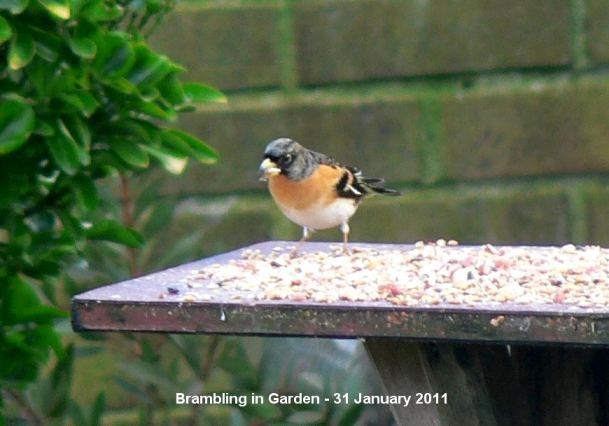
Tony Wootton went to Blashford Lakes on Feb 3 to check out the birds for Saturday's walk by the Havant Wildlife Group. In the space of 3 hours (11 to 2) from the North Ivy Lake hide he saw all the hoped for birds, including one of the Bitterns that have been on the site for over a month, the long staying Great White Egret and a Water Rail. Tony also saw a Cetti's Warbler and a Buzzard both of which he missed photographically. He was particularly annoyed about the Cetti's because it was very close, but did not make it's usual sound, more like a Wren, so he didn't pick up on it fast enough. Tony also reported plenty of Siskins, Bramblings and Redpoll in the Woodland hide.
Bob Chapman (Warden) reported four Bitterns from Ivy North hide on 26 Jan, including seemingly 2 larger birds (males) and 2 smaller (females). The Great White Egret has been seen at Blashford since July 2010.
Here is Tony's excellent photo of the Bittern
and the Great White Egret taking off
SATURDAY JANUARY 8 - 2011 at CAMS HALLHeather Mills reports on this morning's walk by the Havant Wildlife Group at Cams Hall, Fareham
On a very cold and decidedly iffy day 9 members met at the Delme roundabout to walk along Cams, led by Fay. We started off looking south from the roundabout up the river with much water coming in from the Wallington, after the nights downpour. Good sights of all the usual waders hereabouts. Caroline spotting a Greenshank up on the shingle with a Curlew for company.
As we ventured round we chased a group of Blue Tits and Long-tailed Tits, and stirred a Jay. Dodging the golf balls as we continued, we were fortunate to also dodge low flying black clouds, which passed overhead and gave us better light with which to see about 10 Black-tailed Godwits over the other side of the creek towards Fleetlands where we normally see them. Caroline also alerted us to a Grey Wagtail preening by the wall, a long way off, but never- the-less a good spot.
Further on we had the welcome sight of 2 male and I think 7 or 8 female Goldeneye. Hundreds of Wigeon dotted around the harbour as we approached Portchester, and a substantial flock of Brent Geese, approx 40. A Great Black-backed Gull was keeping company with 2 Cormorants, and we had views through scopes of Turnstones roosting on a small barge, alongside Oystercatchers.
We cut short the final walk and headed back through the woods towards Cams. Lots of Butchers broom in here and Spurge laurel nearly out. Better views of a jay who retrieved an acorn in front of us from the lawns running back down to the main A27.
Good fresh air, fine birding and pleasant company.
FOR WALKS REPORTS FOR 2010 GO TO . . . Saturday walks - reports - 2010
